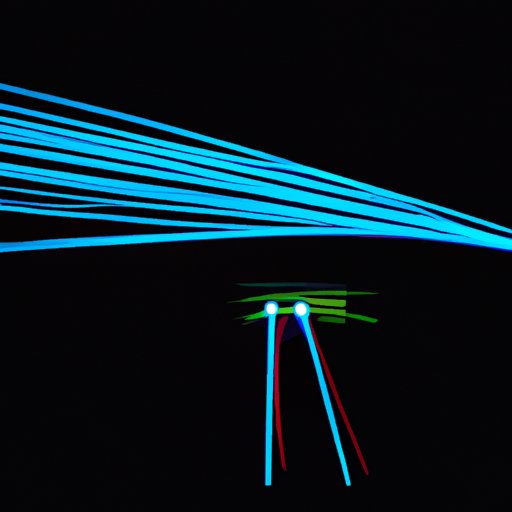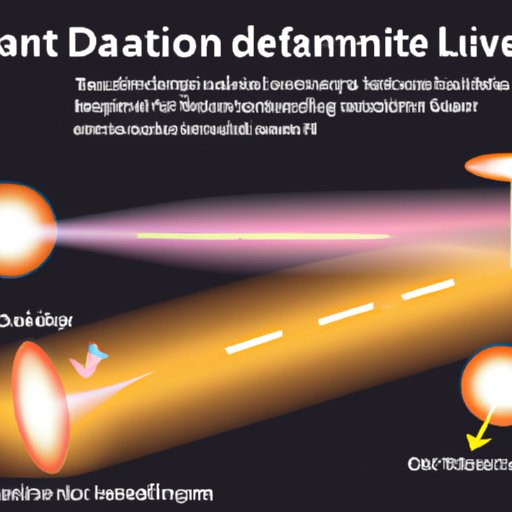Introduction
The speed of light is one of the most fundamental constants of nature, yet it remains largely mysterious to this day. The speed of light, often referred to as “c”, is the rate at which light travels through a vacuum. This constant has been measured and calculated to be approximately 299,792,458 meters per second, or 186,282 miles per second. This article will explore the history, science and technology behind the speed of light, as well as provide insight into how to calculate the speed of light and compare it to other phenomena.
Historical Perspective
Although the speed of light has been known for centuries, accurate measurements of its speed have only been possible since the late 19th century. In 1676, Danish astronomer Ole Roemer was the first to make an accurate measurement of the speed of light. He observed the eclipses of Jupiter’s moons and concluded that the speed of light must be finite. However, it was not until 1849 when French physicist Armand Fizeau became the first person to measure the speed of light accurately. He used an apparatus that allowed him to measure the time it took for light to travel between two points several kilometers apart. Since then, scientists have continued to refine their measurements of the speed of light.
It was not until the 20th century that Albert Einstein proposed his Theory of Relativity, which revolutionized our understanding of the speed of light. According to the theory, the speed of light in a vacuum is constant, regardless of the observer’s motion. This means that the speed of light is the same for all observers, no matter how they are moving relative to each other. This groundbreaking discovery helped to further our understanding of the universe and paved the way for many scientific advances.

Examining the Science Behind the Speed of Light
Light is composed of particles called photons, which are the fundamental units of electromagnetic radiation. These photons travel through space at a constant speed and interact with matter as they pass through it. When a photon interacts with an atom, it can cause the atom to emit its own photons, which then propagate outwards in all directions.
Light is made up of three components: electric fields, magnetic fields, and a wave-like behavior. Electric and magnetic fields are created by the movement of charged particles, while the wave-like behavior of light is due to the fact that light is made up of oscillating electric and magnetic fields. All three components contribute to the speed of light, but the electric and magnetic fields are the primary drivers of the speed of light.

Exploring the Impact of Speed of Light on Technology
The speed of light has had a profound impact on modern technology. It is used in telecommunications, allowing us to communicate over long distances in real-time. It is also used in astronomy, helping us to observe distant objects in the universe. Finally, it is used in computing, allowing us to process vast amounts of information quickly and efficiently.
In telecommunications, the speed of light is used to transmit data over long distances. Light waves travel faster than any other signal, meaning they can carry more information than other signals. This makes them ideal for transmitting large amounts of data quickly and reliably.
In astronomy, the speed of light is used to observe distant objects in the universe. By measuring the amount of time it takes for light to travel from a distant object to Earth, astronomers can calculate the distance to the object. This can help us to understand more about the structure of the universe.
Finally, the speed of light is used in computing. Computers use light to process data, as light can travel much faster than electrons. This allows computers to process vast amounts of information quickly and efficiently, making them indispensable tools in our modern world.
How to Calculate Speed of Light
Calculating the speed of light is relatively straightforward. The formula for calculating the speed of light is c = λ x f, where c is the speed of light, λ is the wavelength of the light, and f is the frequency of the light. This formula can be used to calculate the speed of light in different circumstances.
In addition to using physics formulas, there are also technological methods of calculating the speed of light. For example, devices such as laser rangefinders can measure the time it takes for light to travel between two points, allowing us to accurately calculate the speed of light.
Comparing the Speed of Light to Other Phenomena
The speed of light is incredibly fast, but it is not the fastest phenomenon in the universe. Sound, for example, travels much slower than light, at a speed of around 340 meters per second in air. Electricity is even slower, traveling at around 0.3 meters per second.
It is also important to note that the speed of light is not constant. It can be affected by various factors, such as the medium it is traveling through. For example, light travels faster in a vacuum than it does in water or air. This is because the molecules in water and air absorb some of the energy from the light, slowing it down.
Investigating the Role of Gravity in Slowing Down the Speed of Light
Gravity is one of the forces that can affect the speed of light. According to Einstein’s Theory of General Relativity, gravity can bend light rays, causing them to travel slower than they would in a vacuum. This is known as gravitational time dilation, and it has been observed in experiments involving gravitational lenses.
Gravitational time dilation is caused by the fact that the force of gravity is stronger near massive objects, such as black holes. As light passes close to these objects, it is bent and slowed down. This effect is known as the “gravitational redshift” and can be measured experimentally.

Understanding the Effects of Time Dilation Due to Speed of Light
Time dilation is another phenomenon related to the speed of light. According to Einstein’s Theory of Special Relativity, time runs slower for objects moving at high speeds relative to an observer. This means that if two observers were moving at different speeds, they would experience time passing at different rates.
For example, if one observer was moving at the speed of light, time would appear to stand still for them. This phenomenon is known as time dilation, and it has been observed in experiments involving particles moving at close to the speed of light.
Conclusion
The speed of light is one of the most fundamental constants of nature, yet it remains largely mysterious to this day. This article explored the history, science and technology behind the speed of light, as well as provided insight into how to calculate the speed of light and compare it to other phenomena. We also investigated the role of gravity and time dilation in slowing down the speed of light. Our findings suggest that the speed of light is an incredible phenomenon that continues to fascinate scientists and laypeople alike.
Further research should be conducted to better understand the effects of gravity and time dilation on the speed of light. Additionally, more research should be done to explore the potential applications of the speed of light in modern technology. With more research, we can continue to expand our understanding of this fascinating phenomenon.
(Note: Is this article not meeting your expectations? Do you have knowledge or insights to share? Unlock new opportunities and expand your reach by joining our authors team. Click Registration to join us and share your expertise with our readers.)
